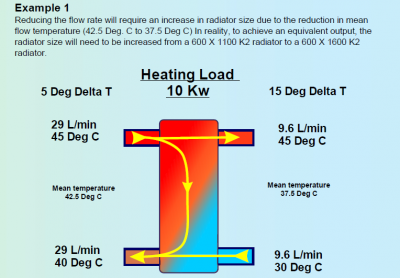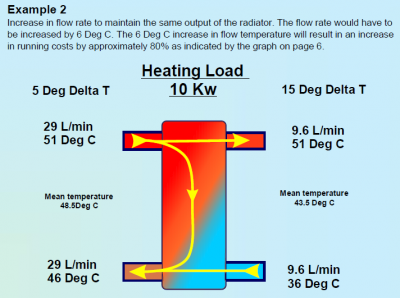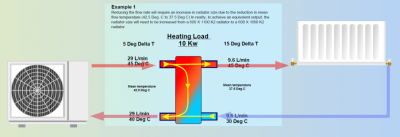@transparent Your picture of a volumizer is correct, you must be careful that you have 10-15 liters of open zone (free flowing without control) water volume per Kw and a flow rate of between 2 and 2,5 liters/min of peak heat pump power.
Below are some cutouts describing distortion and the implications within a buffer.
Thanks @heacol
Let me check I've understood those diagrams...
Is the ASHP on the left and the radiator(s) on the right like this?
Posted by: @editor[...] a 4-port buffer, with proper balancing on both sides of the hydraulic separation to minimise distortion (aka, blending).
I take this comment to mean:
"If the flow through the radiator loop is too great, then the cold/return water to the buffer would get mixed into the radiator flow;
but it should be mixing only into the return to the HP."
That would appear to take a lot of skill to optimise.
Save energy... recycle electrons!
Posted by: @transparentThat would appear to take a lot of skill to optimise.
... particularly if you have TRVs and zone valves randomly switching on and off, which may well have been part of the 'justification' for the buffer tank in the first place.
I believe that one way to balance a buffer tank is to have temperature sensors one third and two thirds up the tank. The pumps can then be controlled to keep the thermocline between the sensors, thus balancing the tank. I don't know if any heat pumps build this functionality in natively, or whether installers who put in buffer tanks enable it. However I can see that this closed loop control could work, whereas I cant personally see how an open loop system ever could.
4kW peak of solar PV since 2011; EV and a 1930s house which has been partially renovated to improve its efficiency. 7kW Vaillant heat pump.
@transparent You are correct on both accounts, the picture is correct, and it is exceptionally difficult to balance a buffer in normal circumstances.
@jamespa correct, but why make things complicated when a system without a buffer works so well? In my experience, simplicity is always the best option.
Posted by: @heacol@jamespa correct, but why make things complicated when a system without a buffer works so well? In my experience, simplicity is always the best option.
100% agreed, I am a firm believer in the liberal use of occams razor!. I was just saying it (balancing a buffer) can be done, although it seems, judging by the posts on this forum, that it rarely is done.
4kW peak of solar PV since 2011; EV and a 1930s house which has been partially renovated to improve its efficiency. 7kW Vaillant heat pump.
@jamespa You are again correct, you can balance a buffer tank, just like you can go to the moon 🤣
You can balance a buffer by simply having two flow controller installed either side of it.
One should have already been installed on the ashp side, unless your HP can control the flow rate.
@uk_pete_2000 on Wednesday our next podcast episode will be out and @heacol explains why (and how difficult it is) to monitor the flow on the heating side of the circuit, which makes it incredibly difficult to balance both sides.
Get a copy of The Ultimate Guide to Heat Pumps
Subscribe and follow our YouTube channel!
@editor I agree it can be difficult to get it correct and i came to this site just for that help.
Once I realised that most people had no idea other than to say remove it / you don't need it / should not have been fitted have this etc etc. I took it to find out about them and how to get them running.
I also found that nearlly all HP manufacturers say you should have one otherwise the warranty is invalid. Hopefully this will change as they too come to grips with HP
In the meantime we could have 500,000 HP installed, with buffer, all looking for answers other than - remove it etc.
So by just saying it can't be done, does not mean we can not find some solutions that will help mitigate the problem. Simply things like flow controls, ensure all open zones, correct size CH pumps etc. All can help.
In order to keep within my HP warranty (i hope), I expect to switch to a three port buffer. Thus allowing the seperate sides to still work independently of each other.
I would go fully open and remove the buffer but with 3 manifolds, 24 zones and not running it 24 hrs, I would be taking heat out from my house when the HP does a anti freeze cycle.
Posted by: @uk_pete_2000I also found that nearly all HP manufacturers say you should have one otherwise the warranty is invalid. Hopefully this will change as they too come to grips with HP
Do they? That's not what I observe from the several manuals I have read (albeit in some cases fairly quickly, I admit) over the past 2 years. I wonder if @heacol would like to comment about the 'nearly all HP manufacturers say you should have one', given he is so strongly opposed.
Posted by: @uk_pete_2000So by just saying it can't be done, does not mean we can not find some solutions that will help mitigate the problem.
In general I would support the principle of finding practical solutions except that the fix (based on adding additional flow controls in I think you said) seems usually to involve plumbing, and thus for most people their installer. If the installer is coming back they should just remove the buffer unless there is an objectively justifiable reason not to do so.
4kW peak of solar PV since 2011; EV and a 1930s house which has been partially renovated to improve its efficiency. 7kW Vaillant heat pump.
@uk_pete_2000 I can’t disagree with anything you’ve said. But it’s a big and growing problem, and the main motivation in fitting heat pumps was to get efficient heating systems into UK homes, and buffer tanks are often working against that goal.
The issue isn’t just that buffers are unnecessary in most modern heat pump setups – it’s that they actively reduce efficiency in ways that many homeowners don’t realise. Distortion, increased running costs and reduced heat emitter output all mean that a system with a buffer often performs worse than one without.
You’re absolutely right that manufacturers have historically insisted on buffers to protect warranties, but that’s largely because many systems were being installed with inadequate volume or poor flow control. The industry is slowly catching up, but in the meantime, homeowners like you (who have inherited or been advised to install buffer tanks) are left trying to make the best of a less-than-ideal setup.
Your approach, ensuring correct flow rates, keeping zones open where possible and switching to a three-port buffer, is sensible given your constraints. However, the challenge remains that even with careful mitigation, the fundamental inefficiencies of buffer tanks still apply.
For homeowners with existing buffer tanks, the best course of action is to explore ways to improve the system’s efficiency, as you’re doing. But for new installs, the focus should be on getting the system design right from the outset (sufficient volume in the system, proper flow control and weather-compensated operation) so that buffers aren’t needed in the first place.
Get a copy of The Ultimate Guide to Heat Pumps
Subscribe and follow our YouTube channel!
- 26 Forums
- 2,342 Topics
- 53 K Posts
- 263 Online
- 6,000 Members
Join Us!
Worth Watching
Latest Posts
-

RE: Configuring third party dongle for Ecodan local control
That's a good spot and a valuable insight, @sheriff-fat...
By Majordennisbloodnok , 26 seconds ago
-
RE: Controlling Daikin Altherma via P1P2 and Home Assistant
@majordennisbloodnok Thank you! My biggest head scrat...
By weoleyric , 9 minutes ago
-

RE: Are We Sleepwalking Into Another Race to the Bottom?
@majordennisbloodnok And did ‘Honey’ order it for you? ...
By Toodles , 25 minutes ago
-

RE: Setback savings - fact or fiction?
@robs — thanks again for your detailed comments. Some r...
By cathodeRay , 14 hours ago
-
RE: Free Ecoheat Heat Pump Install
I don't mind thread drift, it's how conversation natura...
By Deltona , 15 hours ago
-

RE: A Smarter Smart Controller from Homely?
@papahuhu I hope you get a swift resolution. Regards, T...
By Toodles , 18 hours ago
-

RE: Poll for Time of Use, tariffs, technology
That’s fine by me too Major, I feel it is a sad reflect...
By Toodles , 19 hours ago
-

Bingo. Sometimes a judiciously placed size 10 bovver bo...
By Majordennisbloodnok , 19 hours ago
-
RE: Mitsubishi Ecodan 11.2kW heat pump with low COP
@ciocoiu-alexandru I can't provide the same level of di...
By Sheriff Fatman , 20 hours ago
-
RE: Octopus Cosy Heat Pump Owners & Discussion Thread
Recently had my follow up with octopus for the vibratio...
By swwils , 21 hours ago
-

The three technical issues I'm considering are: BMS...
By Transparent , 22 hours ago
-
RE: LiFePO4 lithium battery fires and explosions
@transparent Your post may fit better in th...
By Batpred , 22 hours ago
-

RE: British Gas vs Octopus Energy vs Heat Geek vs EDF vs Aira vs OVO vs EON.Next vs Boxt
@jamespawhite, if you could be bothered, you could also...
By Mars , 24 hours ago
-
RE: Commencing on an ASHP Installation Process
I've got a bit of time to draft something today, so the...
By Sheriff Fatman , 2 days ago
-
RE: Help with heat pump sizing
@amin I dont think materially relative to t...
By JamesPa , 2 days ago
-

@majordennisbloodnok I have decided to take the plunge....
By TechnoGeek , 2 days ago
-
RE: Different dT on each radiator?
I cant sorry. Its based on some calculations I did fro...
By JamesPa , 3 days ago
-
RE: Help me keep the faith with my air source heat pump installation
@simonf thats interesting as I’ve noticed my flow and r...
By AdamK , 3 days ago









